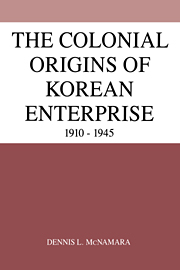5 - The Mins and Finance
Published online by Cambridge University Press: 14 October 2009
Summary
The Min clan from Yŏhŭg near Yŏju in Kyŏnggi Province gained prominence at the end of the Chosŏn Dynasty with the decline of the Andong Kim clan. Viscount Min Yŏng-hwi (1852–1935; pen name, Hajŏng) and his sons, Taesik and Kyu-sik, turned their energies mainly to finance, with interests in agriculture and industry as well. The father had been appointed to the board of the Hanil Bank in August of 1912. Within three years Min Yŏng-hwi won executive control, relinquishing the presidency to his son Tae-sik only in 1920. The family retained executive responsibilities and the major block of shares in the Hanil and its successor from 1931, the Tongil Bank. Aristocratic status and long experience of high political office served the family well in relations with the state and other Korean investors during the colonial years. Education abroad was a further advantage for the younger of the sons, Kyu-sik, a graduate of Cambridge University. Min Tae-sik's son, Pyŏng-do graduated from Keio University before returning to Korea for a career in the Bank of Chōsen and the Tongil.
A study of Min family enterprise opens up the world of banking in the turbulent years of colonial rule. One can feel the competition by looking to Min family efforts to take over the Hanil Bank, then other smaller Korean banks, and finally to sustain ownership if not control of the Hanil's successor, the Tongil Bank.
- Type
- Chapter
- Information
- The Colonial Origins of Korean Enterprise1910–1945, pp. 66 - 83Publisher: Cambridge University PressPrint publication year: 1990



